Abstract
The biologic role of calcium and guanosine 3':5'-monophosphate (cyclic GMP) in the immunologic secretion of lysosomal enzymes from human neutrophils was studied. Contact of neutrophils with zymosan-treated serum or the divalent cation ionophore A-23187, in the presence of extracellular calcium, resulted in beta-glucuronidase (beta-D-glucuronide glucuronosohydrolase, EC 3.2.1.31) secretion and a concomitant accumulation of cyclic GMP without any loss of cell viability. Acetylcholine (0.1 muM), in the presence of calcium, enhanced the immunologic stimulation of cyclic GMP accumulation and lysosomal enzyme discharge. A marked and rapid association of 45CaCl2 with neutrophils occurred during cell surface contact with zymosan-treated serum, and this effect on calcium association was enhanced with 0.1 muM acetylcholine. The precise mechanism of the neutrophil-calcium interaction is presently not well understood. However, the finding that 0.5-1.0 muM A-23187 also provoked a rapid association of extracellular calcium with neutrophils suggests that calcium mobilization into the intracellular environment may account, at least in part, for this association between cells and calcium. The close temporal relationship between beta-glucuronidase secretion, cyclic GMP accumulation, and calcium mobilization during cell contact with membrane active agents such as immune reactants, acetylcholine, and ionophores suggests that these three cellular events bear a cause and effect relationship. On the basis of our findings to date, we propose that the immunologic secretion of lysosomal contents from human neutrophils is signaled by intracellular cyclic GMP and that extracellular calcium, by gaining access to the intracellular processes responsible for cyclic GMP accumulation, serves as the link to stimulus-secretion coupling.
Full text
PDF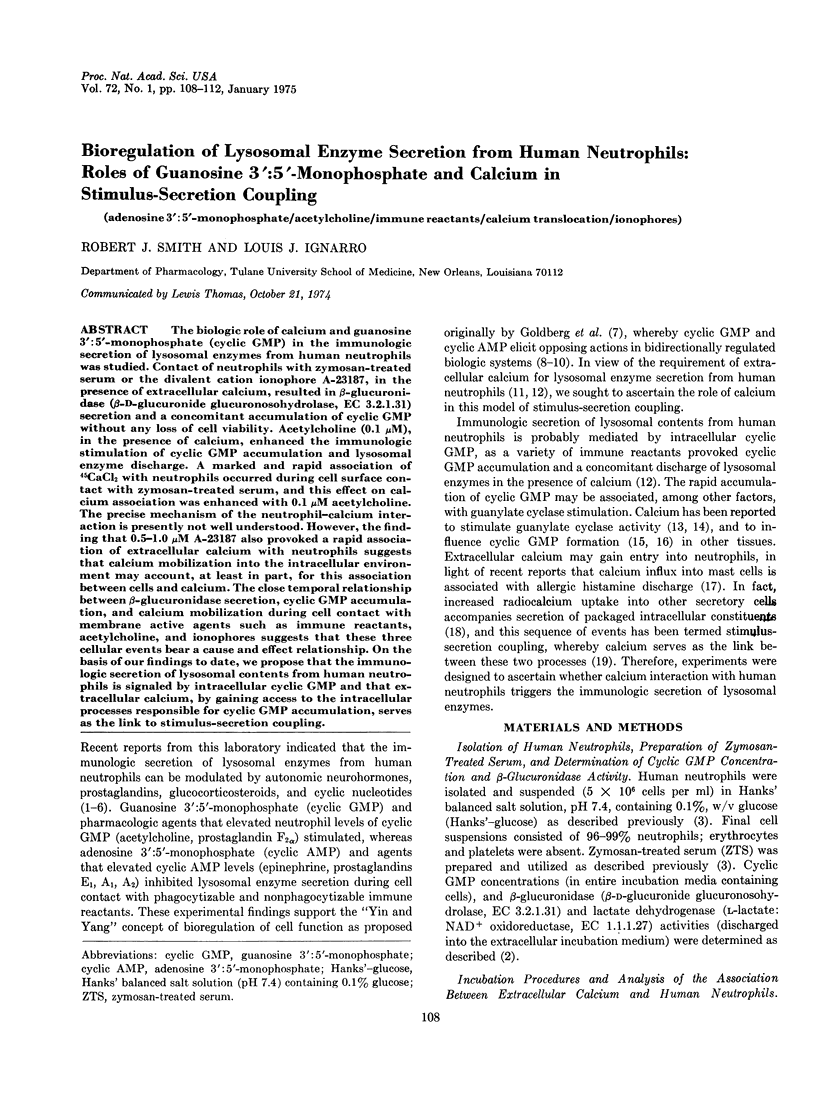
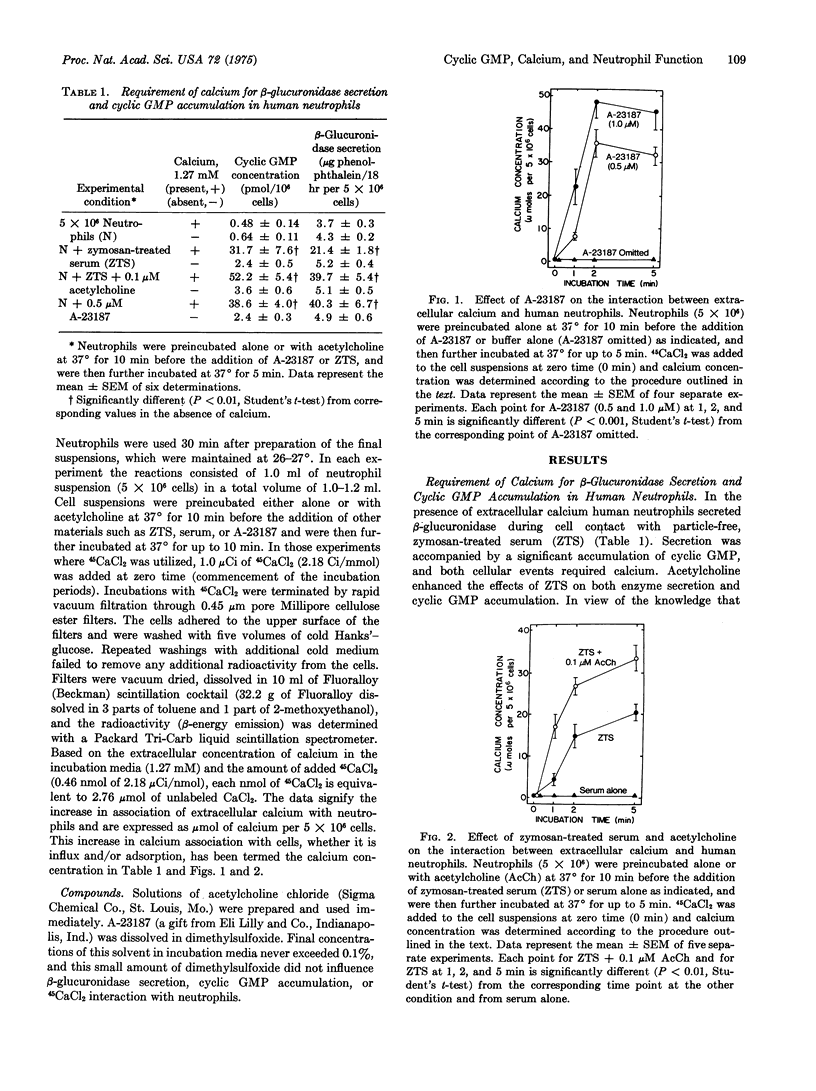
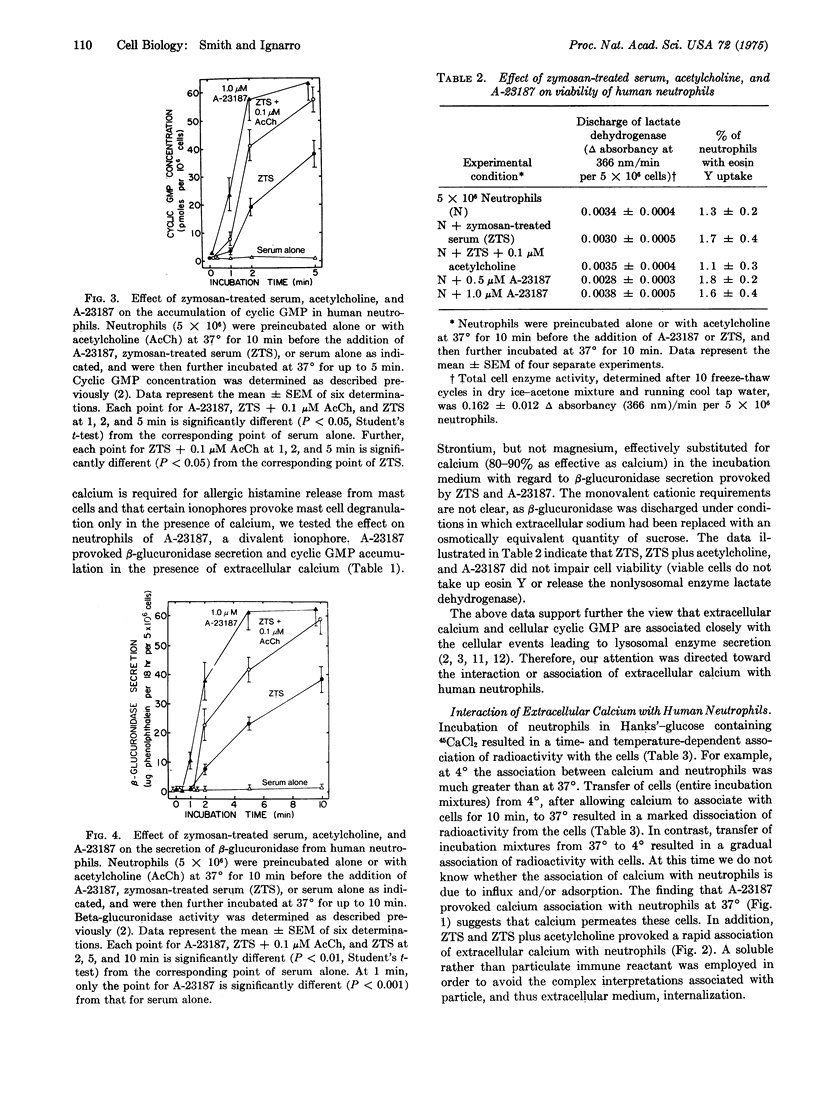
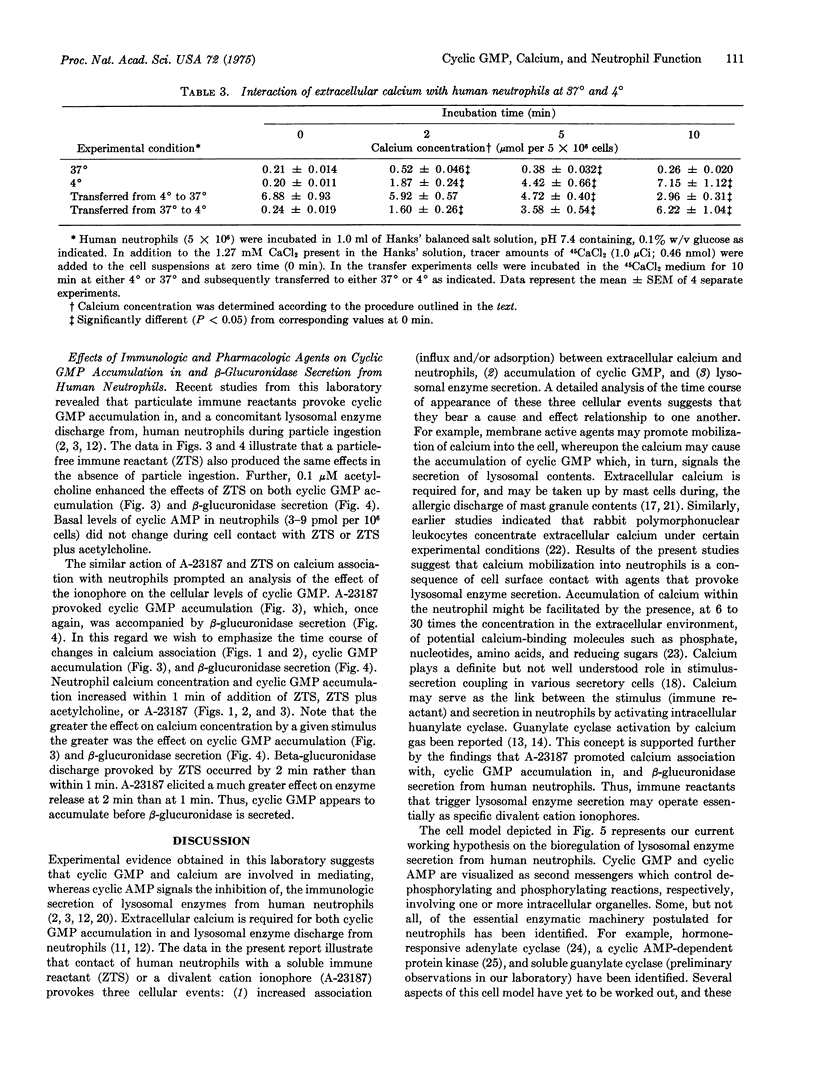
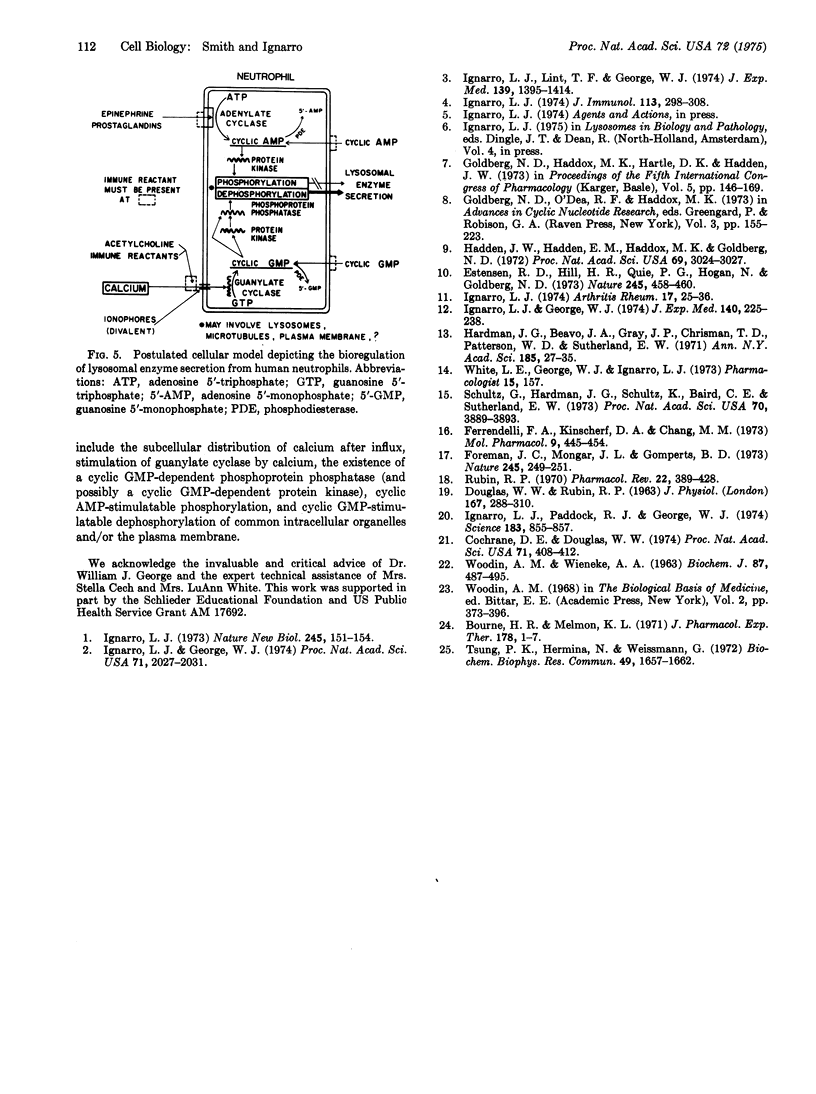
Selected References
These references are in PubMed. This may not be the complete list of references from this article.
- Bourne H. R., Melmon K. L. Adenyl cyclase in human leukocytes: evidence for activation by separate beta adrenergic and prostaglandin receptors. J Pharmacol Exp Ther. 1971 Jul;178(1):1–7. [PubMed] [Google Scholar]
- Cochrane D. E., Douglas W. W. Calcium-induced extrusion of secretory granules (exocytosis) in mast cells exposed to 48-80 or the ionophores A-23187 and X-537A. Proc Natl Acad Sci U S A. 1974 Feb;71(2):408–412. doi: 10.1073/pnas.71.2.408. [DOI] [PMC free article] [PubMed] [Google Scholar]
- Douglas W. W., Rubin R. P. The mechanism of catecholamine release from the adrenal medulla and the role of calcium in stimulus-secretion coupling. J Physiol. 1963 Jul;167(2):288–310. doi: 10.1113/jphysiol.1963.sp007150. [DOI] [PMC free article] [PubMed] [Google Scholar]
- Estensen R. D., Hill H. R., Quie P. G., Gogan N., Goldberg N. D. Cyclic GMP and cell movement. Nature. 1973 Oct 26;245(5426):458–460. doi: 10.1038/245458a0. [DOI] [PubMed] [Google Scholar]
- Ferrendelli J. A., Kinscherf D. A., Chang M. M. Regulation of levels of guanosine cyclic 3',5'-monophosphate in the central nervous system: effects of depolarizing agents. Mol Pharmacol. 1973 Jul;9(4):445–454. [PubMed] [Google Scholar]
- Foreman J. C., Mongar J. L., Gomperts B. D. Calcium ionophores and movement of calcium ions following the physiological stimulus to a secretory process. Nature. 1973 Oct 5;245(5423):249–251. doi: 10.1038/245249a0. [DOI] [PubMed] [Google Scholar]
- Goldberg N. D., O'Dea R. F., Haddox M. K. Cyclic GMP. Adv Cyclic Nucleotide Res. 1973;3:155–223. [PubMed] [Google Scholar]
- Hadden J. W., Hadden E. M., Haddox M. K., Goldberg N. D. Guanosine 3':5'-cyclic monophosphate: a possible intracellular mediator of mitogenic influences in lymphocytes. Proc Natl Acad Sci U S A. 1972 Oct;69(10):3024–3027. doi: 10.1073/pnas.69.10.3024. [DOI] [PMC free article] [PubMed] [Google Scholar]
- Hardman J. G., Beavo J. A., Gray J. P., Chrisman T. D., Patterson W. D., Sutherland E. W. The formation and metabolism of cyclic GMP. Ann N Y Acad Sci. 1971 Dec 30;185:27–35. doi: 10.1111/j.1749-6632.1971.tb45232.x. [DOI] [PubMed] [Google Scholar]
- Ignarro L. J., George W. J. Hormonal control of lysosomal enzyme release from human neutrophils: elevation of cyclic nucleotide levels by autonomic neurohormones. Proc Natl Acad Sci U S A. 1974 May;71(5):2027–2031. doi: 10.1073/pnas.71.5.2027. [DOI] [PMC free article] [PubMed] [Google Scholar]
- Ignarro L. J., George W. J. Mediation of immunologic discharge of lysosomal enzymes from human neutrophils by guanosine 3',5'-monophosphate. Requirement of calcium, and inhibition by adenosine 3',5'-monophosphate. J Exp Med. 1974 Jul 1;140(1):225–238. doi: 10.1084/jem.140.1.225. [DOI] [PMC free article] [PubMed] [Google Scholar]
- Ignarro L. J., Lint T. F., George W. J. Hormonal control of lysosomal enzyme release from human neutrophils. Effects of autonomic agents on enzyme release, phagocytosis, and cylic nucleotide levels. J Exp Med. 1974 Jun 1;139(6):1395–1414. doi: 10.1084/jem.139.6.1395. [DOI] [PMC free article] [PubMed] [Google Scholar]
- Ignarro L. J. Neutral protease release from human leukocytes regulated by neurohormones and cyclic nucleotides. Nat New Biol. 1973 Oct 3;245(144):151–154. doi: 10.1038/newbio245151a0. [DOI] [PubMed] [Google Scholar]
- Ignarro L. J. Nonphagocytic release of neutral protease and beta-glucuronidase from human neutrophils. Regulation by autonomic neurohormones and cyclic nucleotides. Arthritis Rheum. 1974 Jan-Feb;17(1):25–36. doi: 10.1002/art.1780170106. [DOI] [PubMed] [Google Scholar]
- Ignarro L. J., Paddock R. J., George W. J. Hormonal control of neutrophil lysosomal enzyme release: effect of epinephrine on adenosine 3',5'-monophosphate. Science. 1974 Mar 1;183(4127):855–857. doi: 10.1126/science.183.4127.855. [DOI] [PubMed] [Google Scholar]
- Ignarro L. J. Release of neutral protease and beta-glucuronidase from human neutrophils in the presence of cartilage treated with various immunologic reactants. J Immunol. 1974 Jul;113(1):298–308. [PubMed] [Google Scholar]
- Rubin R. P. The role of calcium in the release of neurotransmitter substances and hormones. Pharmacol Rev. 1970 Sep;22(3):389–428. [PubMed] [Google Scholar]
- Schultz G., Hardman J. G., Schultz K., Baird C. E., Sutherland E. W. The importance of calcium ions for the regulation of guanosine 3':5'-cyclic monophosphage levels. Proc Natl Acad Sci U S A. 1973 Dec;70(12):3889–3893. doi: 10.1073/pnas.70.12.3889. [DOI] [PMC free article] [PubMed] [Google Scholar]
- Tsung P. K., Hermina N., Weissmann G. Inosine 3',5'-monophosphate and adenosine 3',5'-monophosphate-dependent protein kinase from human PMN leucocytes. Biochem Biophys Res Commun. 1972 Dec 18;49(6):1657–1662. doi: 10.1016/0006-291x(72)90533-5. [DOI] [PubMed] [Google Scholar]
- WOODIN A. M., WIENEKE A. A. The accumulation of calcium by the polymorphonuclear leucocyte treated with staphylococcal leucocidin and its significance in the extrusion of protein. Biochem J. 1963 Jun;87:487–495. doi: 10.1042/bj0870487. [DOI] [PMC free article] [PubMed] [Google Scholar]


